Release and Degradation Mechanism of Modified Polyvinyl Alcohol-Based Double-Layer Coated Controlled-Release Phosphate Fertilizer
Abstract
:1. Introduction
2. Materials and Methods
2.1. Materials Used in the Experiment
2.2. Preparation of a Double-Layer CRPF
2.2.1. Preparation of BC
2.2.2. Preparation of BC-Doped CTS-Modified PVA/PVP
2.2.3. Preparation of the First and Second Layers of the Film Coating for the CRPF
2.3. Macroscopic Properties of Water-Based Biodegradable Polymer Material
2.3.1. Water Absorbency of PVA/PVP, PVA/PVP-CTSa, and PVA/PVP-CTSaBCb
2.3.2. Biodegradability of PVA/PVP, PVA/PVP-CTS8%, and PVA/PVP-CTS8%BCb
2.3.3. Water Contact-Angle Test
2.3.4. Mechanical Performance Tests
2.4. Phosphorus Release Characteristics
2.5. Characterization of Water-Based Biodegradable Polymer Material
2.5.1. Scanning Electron Microscopy
2.5.2. X-ray Diffraction
2.5.3. Fourier Transform Infrared Spectroscopy
2.5.4. Thermal Properties
3. Results and Discussion
3.1. Effect of Biochar Addition on the Water Absorption of Water-Based Biodegradable Polymer Materials
3.2. Fourier Transform Infrared Spectroscopy
3.3. X-ray Diffraction Analysis
3.4. Thermogravimetric Analysis
3.5. Mechanical Properties
3.6. Effect of BC on the Degradability of PVA/PVP-CTS8%BCb
3.7. Double-Layer CRPF Structure and Phosphorus Release Characteristics in Water
3.8. SEM Images of CRPF Surface
4. Conclusions
Author Contributions
Funding
Data Availability Statement
Conflicts of Interest
References
- Guo, Y.; Zhang, M.; Liu, Z.; Zhao, C.; Lu, H.; Zheng, L.; Li, Y.C. Applying and Optimizing Water-Soluble, Slow-Release Nitrogen Fertilizers for Water-Saving Agriculture. ACS Omega 2020, 5, 11342–11351. [Google Scholar] [CrossRef] [PubMed]
- Kassem, I.; Ablouh, E.-H.; El Bouchtaoui, F.-Z.; Hannache, H.; Ghalfi, H.; Sehaqui, H.; El Achaby, M. Cellulose Nanofibers/Engineered Biochar Hybrid Materials as Biodegradable Coating for Slow-Release Phosphate Fertilizers. ACS Sustain. Chem. Eng. 2022, 10, 15250–15262. [Google Scholar] [CrossRef]
- Lohmousavi, S.M.; Abad, H.H.S.; Noormohammadi, G.; Delkhosh, B. Synthesis and Characterization of a Novel Controlled Release Nitrogen-Phosphorus Fertilizer Hybrid Nanocomposite Based on Banana Peel Cellulose and Layered Double Hydroxides Nanosheets. Arab. J. Chem. 2020, 13, 6977–6985. [Google Scholar] [CrossRef]
- Yang, G.; Zhao, H.; Liu, Y.; Li, Z.; Gao, F.; Zhang, Q.; Zou, P.; Liu, Z.; Zhang, M. Slow Release Fertilizers Based on Polyphosphate/Montmorillonite Nanocomposites for Improving Crop Yield. Arab. J. Chem. 2023, 16, 104871. [Google Scholar] [CrossRef]
- Sarkar, A.; Biswas, D.R.; Datta, S.C.; Roy, T.; Moharana, P.C.; Biswas, S.S.; Ghosh, A. Polymer Coated Novel Controlled Release Rock Phosphate Formulations for Improving Phosphorus Use Efficiency by Wheat in an Inceptisol. Soil Tillage Res. 2018, 180, 48–62. [Google Scholar] [CrossRef]
- Everaert, M.; Warrinnier, R.; Baken, S.; Gustafsson, J.-P.; De Vos, D.; Smolders, E. Phosphate-Exchanged Mg–Al Layered Double Hydroxides: A New Slow Release Phosphate Fertilizer. ACS Sustain. Chem. Eng. 2016, 4, 4280–4287. [Google Scholar] [CrossRef]
- Firmanda, A.; Fahma, F.; Syamsu, K.; Sari, Y.W.; Suryanegara, L.; Wood, K.; Saito, Y. Factors Influencing the Biodegradability of Agro-Biopolymer Based Slow or Controlled Release Fertilizer. J. Polym. Environ. 2023, 31, 1706–1724. [Google Scholar] [CrossRef]
- Boonying, P.; Boonpavanitchakul, K.; Kangwansupamonkon, W. Green Bio-Composite Coating Film from Lignin/Pre-Vulcanized Natural Rubber Latex for Controlled-Release Urea Fertilizer. J. Polym. Environ. 2023, 31, 1642–1655. [Google Scholar] [CrossRef]
- Geng, J.; Ma, Q.; Chen, J.; Zhang, M.; Li, C.; Yang, Y.; Yang, X.; Zhang, W.; Liu, Z. Effects of Polymer Coated Urea and Sulfur Fertilization on Yield, Nitrogen Use Efficiency and Leaf Senescence of Cotton. Field Crops Res. 2016, 187, 87–95. [Google Scholar] [CrossRef]
- Chen, S.; Han, Y.; Yang, M.; Zhu, X.; Liu, C.; Liu, H.; Zou, H. Hydrophobically Modified Water-Based Polymer for Slow-Release Urea Formulation. Prog. Org. Coat. 2020, 149, 105964. [Google Scholar] [CrossRef]
- Cinelli, P.; Chiellini, E.; Gordon, S.H.; Imam, S.H. Characteristics and degradation of hybrid composite films prepared from PVA, starch and lignocellulosics. Macromol. Symp. 2003, 197, 143–156. [Google Scholar] [CrossRef]
- Duan, Q.; Jiang, S.; Chen, F.; Li, Z.; Ma, L.; Song, Y.; Yu, X.; Chen, Y.; Liu, H.; Yu, L. Fabrication, Evaluation Methodologies and Models of Slow-Release Fertilizers: A Review. Ind. Crops Prod. 2023, 192, 116075. [Google Scholar] [CrossRef]
- Lu, H.; Tian, H.; Liu, Z.; Zhang, M.; Zhao, C.; Guo, Y.; Guan, R.; Chen, Q.; Yu, X.; Wang, H.; et al. Polyolefin Wax Modification Improved Characteristics of Nutrient Release from Biopolymer-Coated Phosphorus Fertilizers. ACS Omega 2019, 4, 20402–20409. [Google Scholar] [CrossRef] [PubMed]
- Zhao, X.; Qi, X.; Chen, Q.; Ao, X.; Guo, Y. Sulfur-Modified Coated Slow-Release Fertilizer Based on Castor Oil: Synthesis and a Controlled-Release Model. ACS Sustain. Chem. Eng. 2020, 8, 18044–18053. [Google Scholar] [CrossRef]
- Zhou, Z.; Du, C.; Li, T.; Shen, Y.; Zeng, Y.; Du, J.; Zhou, J. Biodegradation of a Biochar-Modified Waterborne Polyacrylate Membrane Coating for Controlled-Release Fertilizer and Its Effects on Soil Bacterial Community Profiles. Environ. Sci. Pollut. Res. 2015, 22, 8672–8682. [Google Scholar] [CrossRef] [PubMed]
- Devassine, M.; Henry, F.; Guerin, P.; Briand, X. Coating of Fertilizers by Degradable Polymers. Int. J. Pharm. 2002, 242, 399–404. [Google Scholar] [CrossRef] [PubMed]
- Liu, X.; Wu, L.; Zhou, W.; Hu, L.; Lv, J.; Du, W. Environment-Friendly Bio-Based Controlled-Release Phosphate Fertilizer with Waste Kitchen Oil as Coating Material: Preparation, Characterization, and Mechanisms. J. Environ. Manag. 2022, 324, 116409. [Google Scholar] [CrossRef]
- Liu, X.; Yang, Y.; Gao, B.; Li, Y.; Wan, Y. Environmentally Friendly Slow-Release Urea Fertilizers Based on Waste Frying Oil for Sustained Nutrient Release. ACS Sustain. Chem. Eng. 2017, 5, 6036–6045. [Google Scholar] [CrossRef]
- Tanan, W.; Panichpakdee, J.; Suwanakood, P.; Saengsuwan, S. Biodegradable Hydrogels of Cassava Starch-g-Polyacrylic Acid/Natural Rubber/Polyvinyl Alcohol as Environmentally Friendly and Highly Efficient Coating Material for Slow-Release Urea Fertilizers. J. Ind. Eng. Chem. 2021, 101, 237–252. [Google Scholar] [CrossRef]
- Nooeaid, P.; Chuysinuan, P.; Pitakdantham, W.; Aryuwananon, D.; Techasakul, S.; Dechtrirat, D. Eco-Friendly Polyvinyl Alcohol/Polylactic Acid Core/Shell Structured Fibers as Controlled-Release Fertilizers for Sustainable Agriculture. J. Polym. Environ. 2021, 29, 552–564. [Google Scholar] [CrossRef]
- Vo, P.T.; Nguyen, H.T.; Trinh, H.T.; Nguyen, V.M.; Le, A.-T.; Tran, H.Q.; Nguyen, T.T.T. The Nitrogen Slow-Release Fertilizer Based on Urea Incorporating Chitosan and Poly(Vinyl Alcohol) Blend. Environ. Technol. Innov. 2021, 22, 101528. [Google Scholar] [CrossRef]
- Lum, Y.-H.; Shaaban, A.; Mohamad, N.; Dimin, F.; Yatim, N.M. Boric Acid Modified Starch Polyvinyl Alcohol Matrix for Slow Release Fertilizer. e-Polymers 2016, 16, 151–158. [Google Scholar] [CrossRef]
- Chen, S.; Yang, M.; Ba, C.; Yu, S.; Jiang, Y.; Zou, H.; Zhang, Y. Preparation and Characterization of Slow-Release Fertilizer Encapsulated by Biochar-Based Waterborne Copolymers. Sci. Total Environ. 2018, 615, 431–437. [Google Scholar] [CrossRef]
- Kamada, H.; Tsutsumi, Y.; Sato-Kamada, K.; Yamamoto, Y.; Yoshioka, Y.; Okamoto, T.; Nakagawa, S.; Nagata, S.; Mayumi, T. Synthesis of a Poly(Vinylpyrrolidone-Co-Dimethyl Maleic Anhydride) Co-Polymer and Its Application for Renal Drug Targeting. Nat. Biotechnol. 2003, 21, 399–404. [Google Scholar] [CrossRef]
- Zhang, M.; Wang, G.; Zhang, X.; Zheng, Y.; Lee, S.; Wang, D.; Yang, Y. Polyvinyl Alcohol/Chitosan and Polyvinyl Alcohol/Ag@MOF Bilayer Hydrogel for Tissue Engineering Applications. Polymers 2021, 13, 3151. [Google Scholar] [CrossRef] [PubMed]
- Zhang, S.; Feng, J.; Feng, J.; Jiang, Y.; Li, L. Ultra-Low Shrinkage Chitosan Aerogels Trussed with Polyvinyl Alcohol. Mater. Des. 2018, 156, 398–406. [Google Scholar] [CrossRef]
- Aycan, D.; Yayla, N.A.; Aydin, Y.A. Chitosan Polyvinyl Alcohol Blend Films for Ibuprofen Encapsulation: Fabrication, Characterization and Kinetics. Polym. Degrad. Stab. 2020, 181, 109346. [Google Scholar] [CrossRef]
- Aziz, S.B.; Marf, A.S.; Dannoun, E.M.A.; Brza, M.A.; Abdullah, R.M. The Study of the Degree of Crystallinity, Electrical Equivalent Circuit, and Dielectric Properties of Polyvinyl Alcohol (PVA)-Based Biopolymer Electrolytes. Polymers 2020, 12, 2184. [Google Scholar] [CrossRef] [PubMed]
- Phares, C.A.; Atiah, K.; Frimpong, K.A.; Danquah, A.; Asare, A.T.; Aggor-Woananu, S. Application of Biochar and Inorganic Phosphorus Fertilizer Influenced Rhizosphere Soil Characteristics, Nodule Formation and Phytoconstituents of Cowpea Grown on Tropical Soil. Heliyon 2020, 6, e05255. [Google Scholar] [CrossRef]
- Islam, T.; Li, Y.; Cheng, H. Biochars and Engineered Biochars for Water and Soil Remediation: A Review. Sustainability 2021, 13, 9932. [Google Scholar] [CrossRef]
- Rubel, R.I.; Wei, L. Biochar-Based Controlled Release Nitrogen Fertilizer Coated with Polylactic Acid. J. Polym. Environ. 2022, 30, 4406–4417. [Google Scholar] [CrossRef]
- Nahida, J.H. Study of Starch, Sugar Blending Effect on the Biodegradability of (PVA) for Packaging Applications. Iraqi J. Phys. 2019, 15, 43–56. [Google Scholar] [CrossRef]
- Li, B.; Ding, S.; Fan, H.; Ren, Y. Experimental Investigation into the Effect of Pyrolysis on Chemical Forms of Heavy Metals in Sewage Sludge Biochar (SSB), with Brief Ecological Risk Assessment. Materials 2021, 14, 447. [Google Scholar] [CrossRef]
- Bag, O.; Tekin, K.; Karagoz, S. Microporous Activated Carbons from Lignocellulosic Biomass by KOH Activation. Fuller. Nanotub. Carbon Nanostruct. 2020, 28, 1030–1037. [Google Scholar] [CrossRef]
- Chen, J.; Fan, X.; Zhang, L.; Chen, X.; Sun, S.; Sun, R. Research Progress in Lignin-Based Slow/Controlled Release Fertilizer. ChemSusChem 2020, 13, 4356–4366. [Google Scholar] [CrossRef] [PubMed]
- Wang, S.; Li, X.; Ren, K.; Huang, R.; Lei, G.; Shen, L.; Zhan, Y.; Jiang, L. Surface Modification of Pyrophyllite for Optimizing Properties of Castor Oil-Based Polyurethane Composite and Its Application in Controlled-Release Fertilizer. Arab. J. Chem. 2023, 16, 104400. [Google Scholar] [CrossRef]
- Karim, A.A.; Kumar, M.; Mohapatra, S.; Singh, S.K. Nutrient Rich Biomass and Effluent Sludge Wastes Co-Utilization for Production of Biochar Fertilizer through Different Thermal Treatments. J. Clean. Prod. 2019, 228, 570–579. [Google Scholar] [CrossRef]
- Chiaregato, C.G.; Souza, C.F.; Faez, R. The Fertilizer Release into Water and Soil as the Biodegradation Process in the Sustainable Material Enhancing the Fertilizer Efficiency. Environ. Technol. Innov. 2021, 22, 101417. [Google Scholar] [CrossRef]


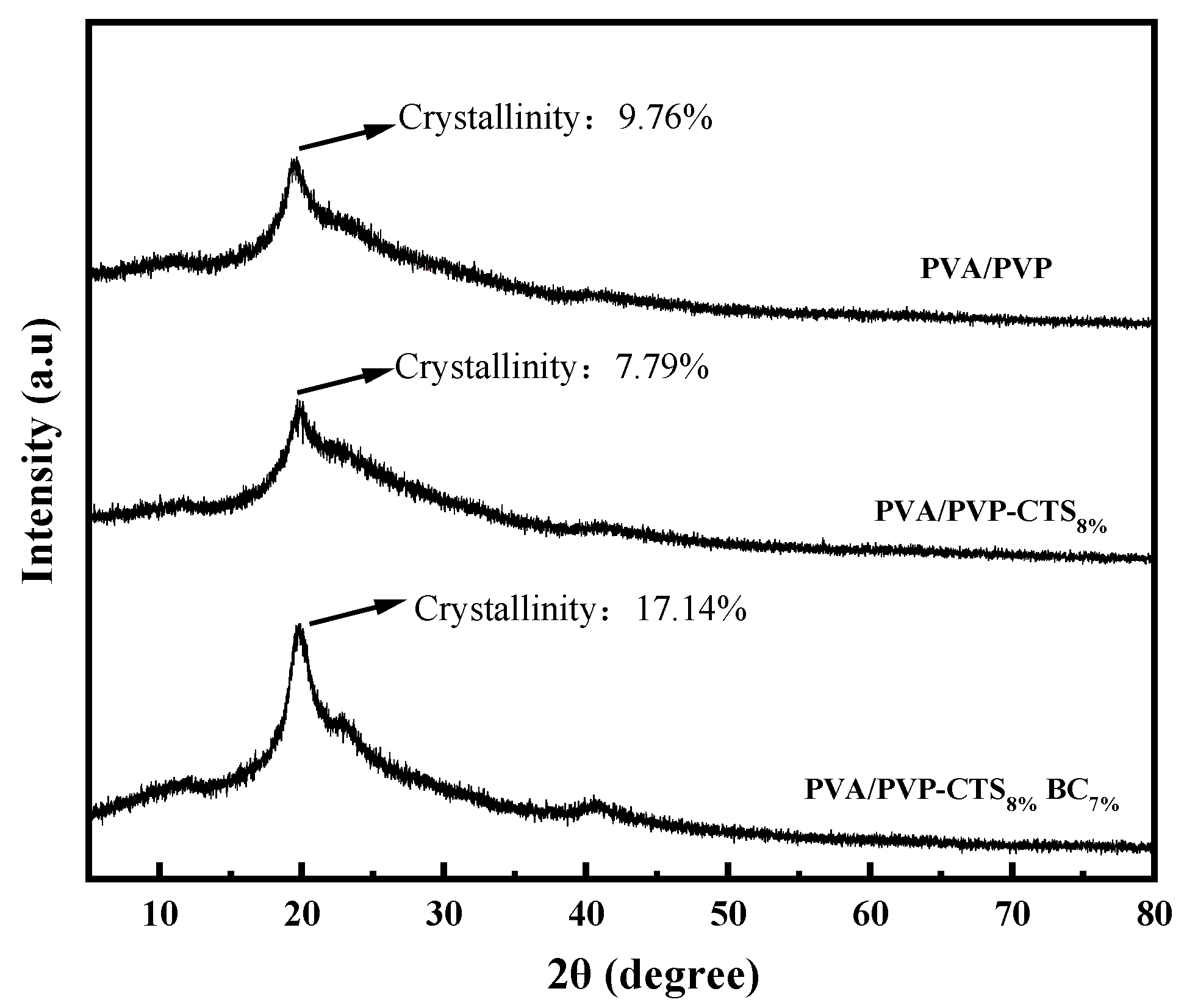
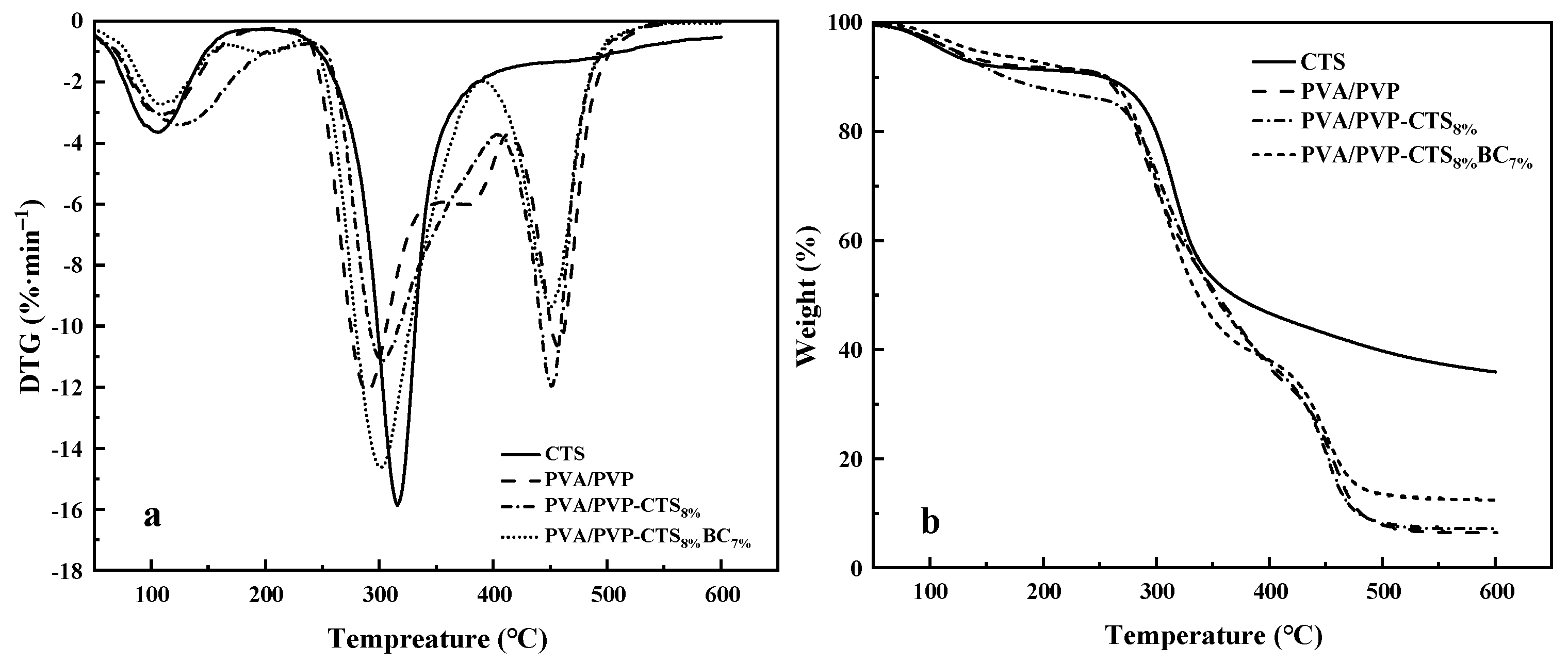
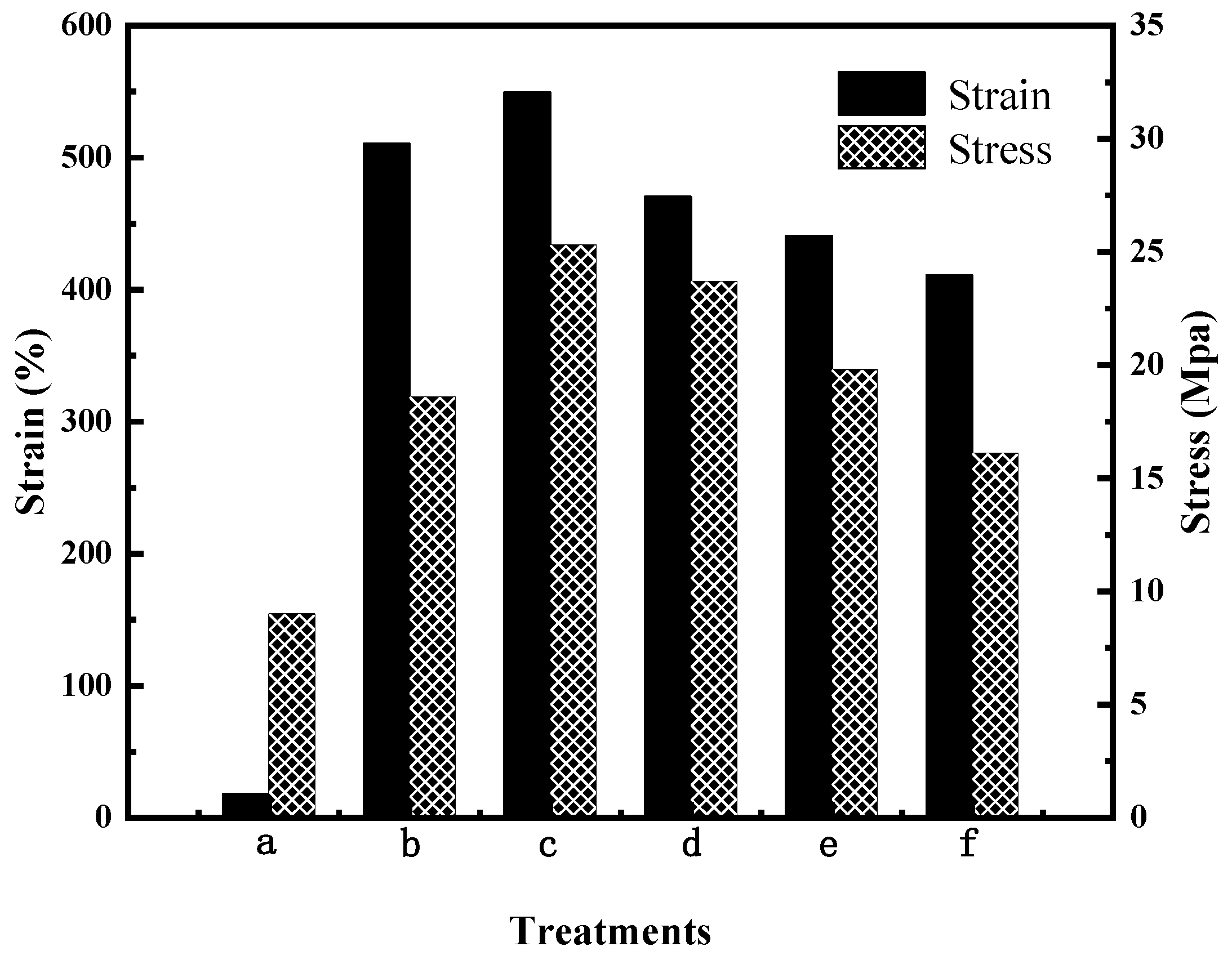

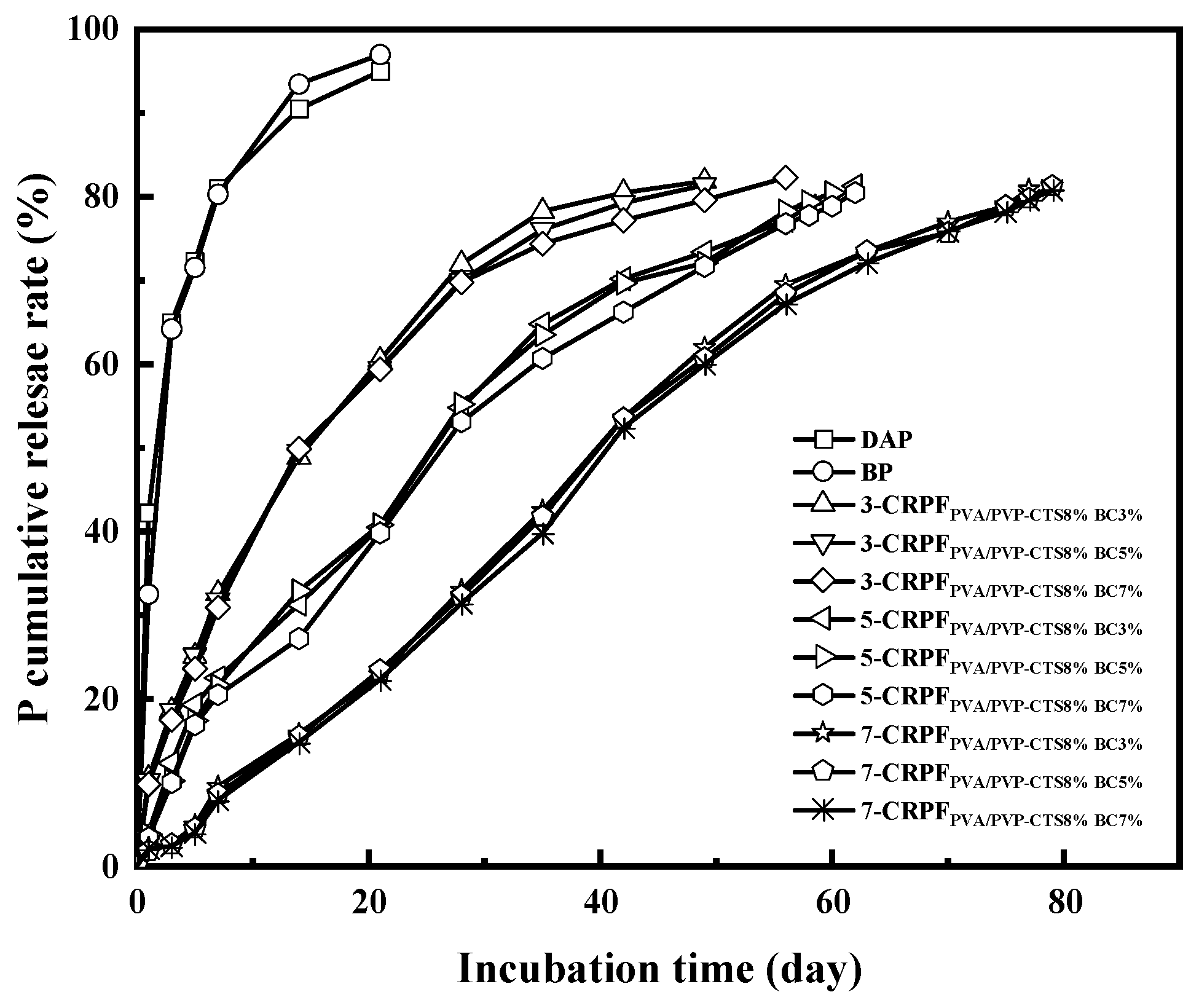
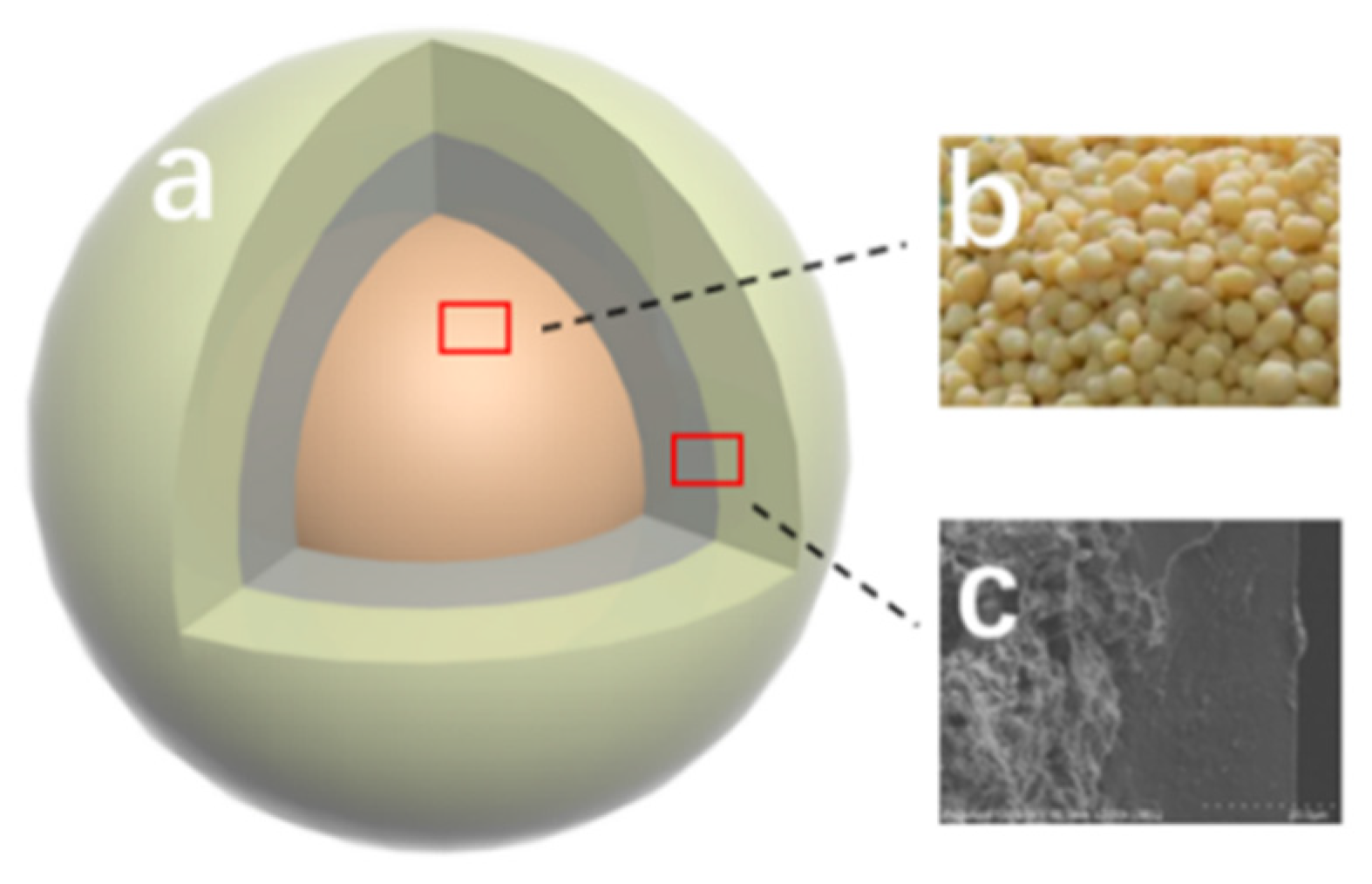
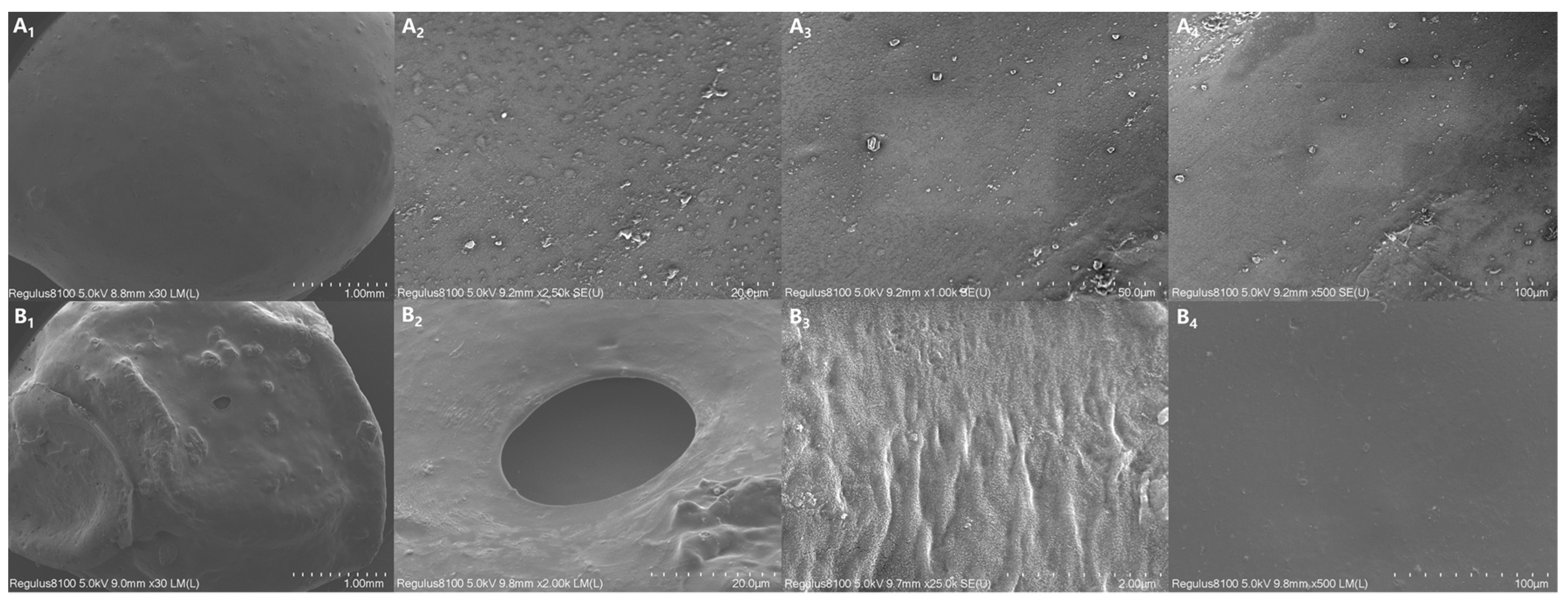
| Method | Controlled-Release Performance (Accumulated Release Amount/Time) | Degradation Performance (Accumulated Degradation Amount/Time) | Reference |
|---|---|---|---|
| Polyvinyl alcohol/polyvinylpyrrolidone/biochar | 60%/20 days | 30%/120 days | Chen et al. [23] |
| Starch–g-polyacrylic acid/natural rubber/polyvinyl alcohol | 62%/3 days | 90%/120 days | Tanan et al. [19] |
| Epoxy resin/biobased polyurethane | 10%/20 days | 8%/120 days | Liu et al. [18] |
| PVA/PVP-CTS8%BC7% | 23%/21 days | 35%/120 days | This work |
Disclaimer/Publisher’s Note: The statements, opinions and data contained in all publications are solely those of the individual author(s) and contributor(s) and not of MDPI and/or the editor(s). MDPI and/or the editor(s) disclaim responsibility for any injury to people or property resulting from any ideas, methods, instructions or products referred to in the content. |
© 2024 by the authors. Licensee MDPI, Basel, Switzerland. This article is an open access article distributed under the terms and conditions of the Creative Commons Attribution (CC BY) license (https://creativecommons.org/licenses/by/4.0/).
Share and Cite
Sun, T.; Zhan, D.; Wang, X.; Guo, Q.; Wu, M.; Shen, P.; Wu, M. Release and Degradation Mechanism of Modified Polyvinyl Alcohol-Based Double-Layer Coated Controlled-Release Phosphate Fertilizer. Polymers 2024, 16, 1041. https://doi.org/10.3390/polym16081041
Sun T, Zhan D, Wang X, Guo Q, Wu M, Shen P, Wu M. Release and Degradation Mechanism of Modified Polyvinyl Alcohol-Based Double-Layer Coated Controlled-Release Phosphate Fertilizer. Polymers. 2024; 16(8):1041. https://doi.org/10.3390/polym16081041
Chicago/Turabian StyleSun, Teng, Dekang Zhan, Xiangzhu Wang, Qingjie Guo, Mingzhou Wu, Pu Shen, and Man Wu. 2024. "Release and Degradation Mechanism of Modified Polyvinyl Alcohol-Based Double-Layer Coated Controlled-Release Phosphate Fertilizer" Polymers 16, no. 8: 1041. https://doi.org/10.3390/polym16081041






